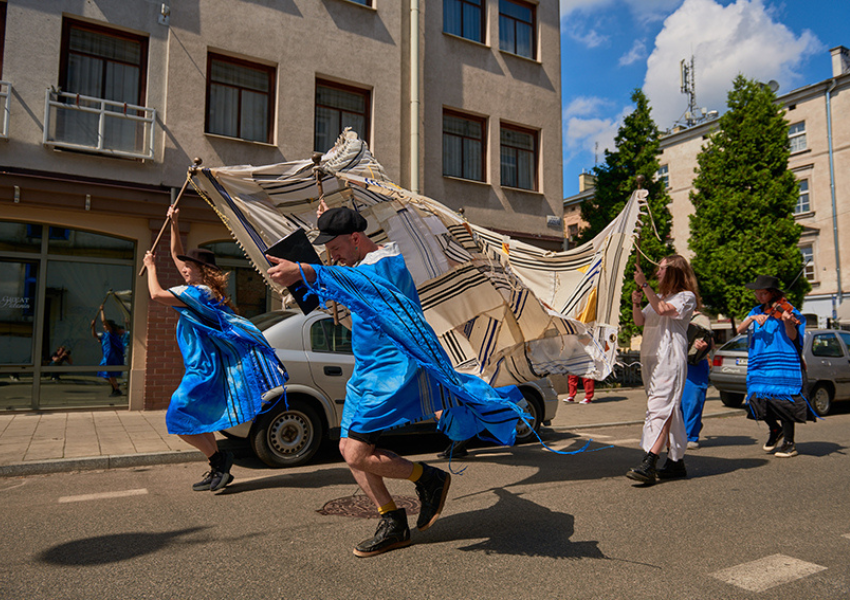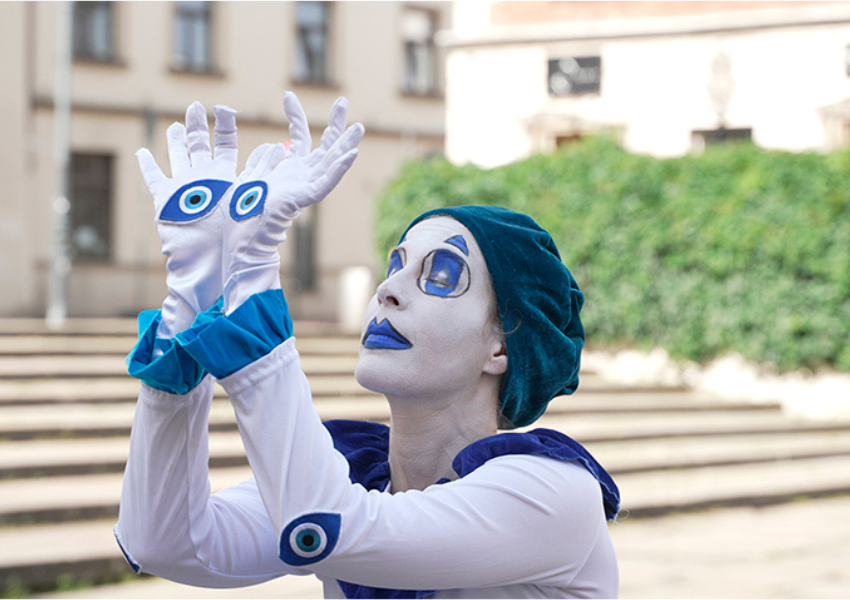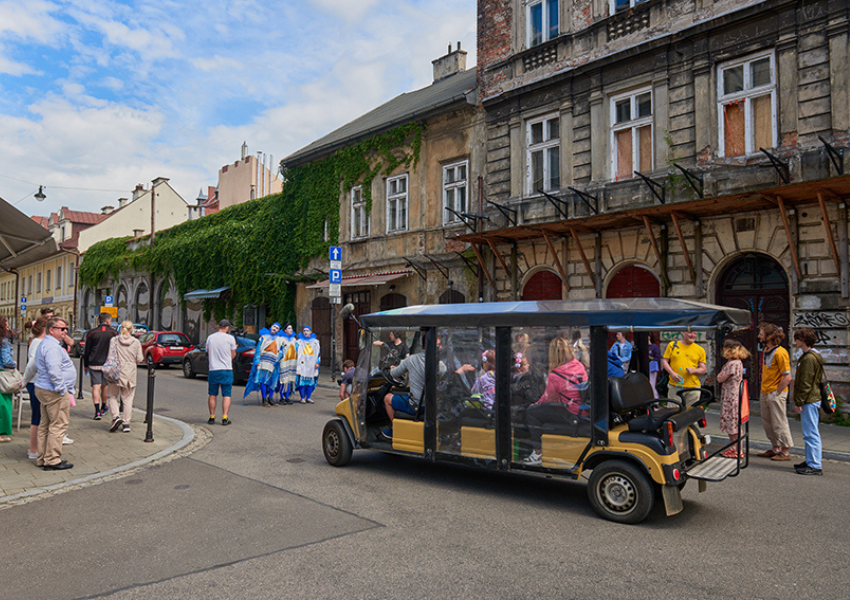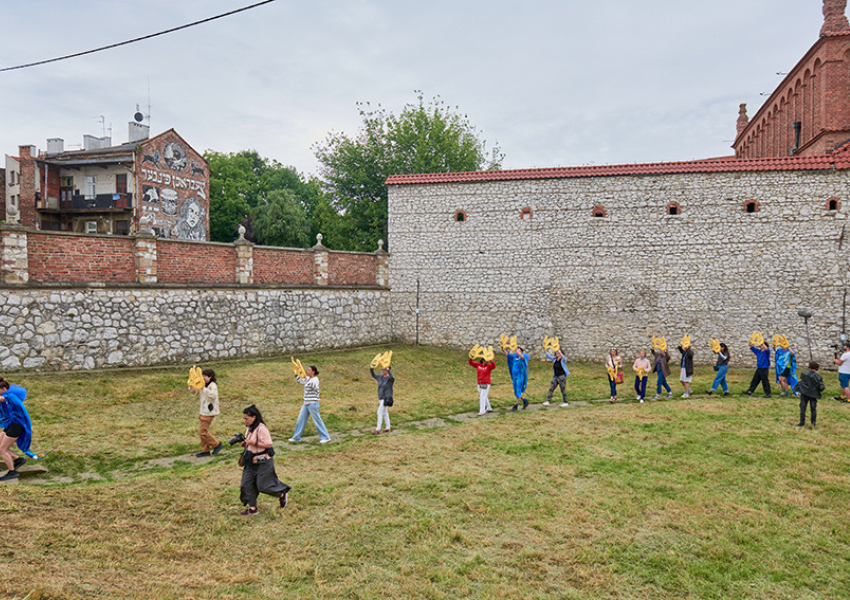Seven Beggars: A Live Street Performance in Krakow
A first look at Julie Weitz's performance art based on the 18th century Hasidic tale
By Julie Weitz
Published Aug 23, 2023

COURTESY KONRAD OBIDZINSKI
Seven Beggars (Royz, Royz), live performance in Krakow, Poland on June 28, 2023
Nothing can prepare you for the unique experience of staging site-specific performance art in the streets of Krakow, Poland during the largest Jewish cultural festival in the world. From June 27 through July 2, 2023, my collaborators and I staged seven live performances at multiple sites in Krakow’s old Jewish neighborhood, Kazimierz, which has been a center of Ashkenazi life for centuries. The performance artwork was titled Seven Beggars, and was commissioned by the Galicia Jewish Museum in Krakow.
Let me introduce myself: I am a visual artist and Fulbright scholar whose performance art practice responds to local surroundings with an attuned sensory awareness of ecological and historical contexts. With my newest project, I am staging live performance art in Eastern Europe to reanimate Yiddish folklore and revive Ashkenazi performance traditions in the places where they once flourished but were nearly extinguished by genocide. In this feature, I’m excited to share with you photographic documentation of my first performances in Poland.

COURTESY KONRAD OBIDZINSKI
Seven Beggars (Stammerer)
Perhaps you are familiar with the famous 18th-century Hasidic tale titled “The Seven Beggars” by Rebbe Nachman of Breslov? The story goes something like this: Two children are lost in a forest and seven beggars, each identified by their particular ailment, help them survive. There is a blind beggar, a beggar who cannot hear, a beggar with weak hands, a stammerer, a hunchback, a beggar with a twisted throat, and a beggar without legs.
The children grow up, get married, and call upon the beggars to visit them during their wedding celebration. Each beggar arrives and tells a cryptic story that reveals how their perceived defect is actually a blessing in disguise, which they offer to the newlyweds as a gift.
After months of studying this story with friends and rabbis, I initiated a collaboration with poet Moriel Rothman-Zecher, musician Ira Khonen Temple, and performance-based artist and dramaturge Anna Lublina. As a group, we formulated a question for each beggar and used that inquiry as a prompt to create each performance. We met in New York in April for rehearsals and in June we arrived in Krakow.

Our first performance was of the Blind Beggar and took place at the plaza of Krakow’s Old Synagogue, built in the 15th century and considered the oldest synagogue still standing in Poland. Our prompt was to see nothingness, or what the Kabbalists describe as Ayin me-Yesh (Nothing from Something), the concept that creation takes place out of nothingness.
A resonant idea for any artist, my directive was to move through the plaza with my eyes closed, using my body parts as points of vision. My costume was adorned with eye patches at my elbows, chest, knees, hands, and tush, guiding my movements. The eyes were also protection against the evil spirits, or as we say in Yiddish keynahora, literally translated as “not (keyn) the evil (hara) eye (ayin).”

COURTESY KONRAD OBIDZINSKI
Seven Beggars (Royz, Royz)
The following day, we walked through the streets for forty minutes singing “Royz Royz,” a Yiddish song about longing and exile. We wore old talisim refashioned as capes, upon which I had sewn large satin triangles in shades of gold. Around our necks, we donned blue tuile collars, reminiscent of clowns. The public photographed us, some followed our path, and many were mesmerized by our presence.

COURTESY KONRAD OBIDZINSKI
Seven Beggars (Healing Hands)
Like each beggar’s story, the tone of our performances oscillated between melancholy and joy, humor and seriousness they also varied in terms of audience participation. For the beggar with withered hands, we invited the public to wear foam hand mitts designed in the shape of the Kohanim blessing (Priestly Blessing.) Printed on one side of the mitt was the four-letter Hebrew tetragrammaton YHVH, and on one side was printed the Yiddish word doikayt with its English translation “hereness.” We staged the event in an open field behind the Old Synagogue’s protective wall.
While foam hand mitts are normally used to cheer on sports teams, we activated our hand mitts to rally for healing. We led mirroring exercises in which folks paired off and wordlessly mimicked each others’ hand movements. We also paraded around the field chanting “doikayt” to the tune of “We will rock you.”
Historically, the Yiddish term doikayt was an organizing principle for Jews in early 20th-century Eastern Europe who believed in transcultural solidarity. In the context of our performances, we used the word as a call to be present and pose questions about belonging and embodying Jewishness in the diaspora.

COURTESY KONRAD OBIDZINSKI
Seven Beggars (Withered Hands)
During our performances in Poland, we were “being here now”– embodying our Jewishness for all to see. The experience was exhilarating and exhausting, and it provided insight into the creative ways that we can activate healing through our presence.
In an analysis of The Seven Beggars story, Rabbi Dovid Sears explains that “the qualities that the beggars confer upon the bride and groom are various expressions of being rooted in the ‘whole’ — the transcendent Divine Unity — and not being stranded in the ‘part,’ the illusion of creation as something autonomous, hopelessly conflicted, separate from God.”
By embodying this great Yiddish folktale in Eastern Europe, its symbolic place of origin, our performances challenged nostalgic representations of Jewish culture in the face of historical violence, cultural erasure, and rising antisemitism. Together, as Jews performing in the diaspora, my collaborators and I felt whole.
Julie Weitz is an award-winning interdisciplinary artist based in Los Angeles.
Reflections
Performing in Poland
What does it mean to stage performances inspired by Yiddish folklore at Jewish sites in Krakow, Poland? What feelings does this provoke in you?
Old Talisim as Costumes
How do you feel about the artist’s repurposing of old talisim as costumes? Do you think it is sacred or sacrilegious?
Healing Art
Do you think that performance art holds the potential for healing? How so?
Want more?
Get curated JewishArts.org content in your inbox


